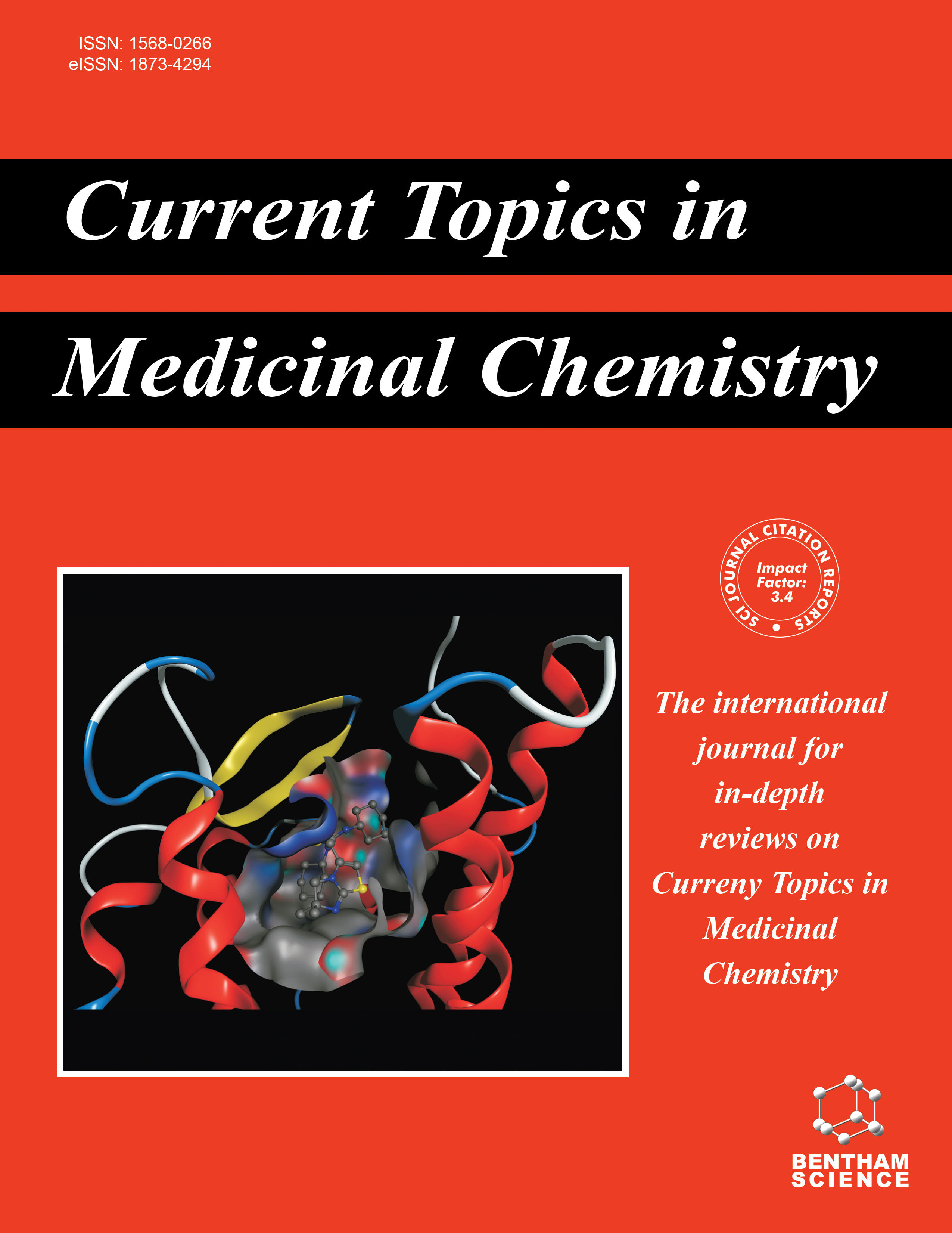- Home
- A-Z Publications
- Current Topics in Medicinal Chemistry
- Previous Issues
- Volume 12, Issue 24, 2012
Current Topics in Medicinal Chemistry - Volume 12, Issue 24, 2012
Volume 12, Issue 24, 2012
-
-
Classification Models for Anticancer Activity
More LessAuthors: R. Dutt and A.K. MadanDespite significant research in understanding of neoplastic diseases, the success rate for oncology drugs is relatively very low. A major challenge before the scientific community is to design new chemical entities that will be highly selective for cancer cells so as to minimize side effects. Classification models (CMs) models play a prominent role in prediction of the biological properties of newly designed compounds before Read More
-
-
-
Fragment-Based Optimization of Small Molecule CXCL12 Inhibitors for Antagonizing the CXCL12/CXCR4 Interaction
More LessAuthors: Joshua J. Ziarek, Yan Liu, Emmanuel Smith, Guolin Zhang, Francis C. Peterson, Jun Chen, Yongping Yu, Yu Chen, Brian F. Volkman and Rongshi LiThe chemokine CXCL12 and its G protein-coupled receptor (GPCR) CXCR4 are high-priority clinical targets because of their involvement in metastatic cancers (also implicated in autoimmune disease and cardiovascular disease). Because chemokines interact with two distinct sites to bind and activate their receptors, both the GPCRs and chemokines are potential targets for small molecule inhibition. A number of chemokin Read More
-
-
-
CORAL: Classification Model for Predictions of Anti-Sarcoma Activity
More LessAuthors: A.A. Toropov, A.P. Toropova, E. Benfenati, G. Gini, D. Leszczynska and J. LeszczynskiA modified version of the CORAL software (http://www.insilico.eu/coral) allows building up the classification model for the case of the Yes/No data on the anti-sarcoma activity of organic compounds. Three random splits into the sub-training, calibration, and test sets of the data for 3017 compounds were examined. The performance of the proposed approach is satisfactory. The average values of the statistical characteris Read More
-
-
-
Abelson Tyrosine-Protein Kinase 1 as Principal Target for Drug Discovery Against Leukemias. Role of the Current Computer-Aided Drug Design Methodologies
More LessAuthors: Alejandro Speck-Planche, Feng Luan and M.N.D.S. CordeiroThe discovery of anti-cancer agents is an area which continues in accelerated expansion. Leukemias (Lkms) are among the most investigated cancers due to its high and dominant prevalence in children. Computer-aided drug design (CADD) methodologies have been extremely important for the discovery of potent anti-Lkms agents, providing essential insights about the molecular patterns which could be involved in the ap Read More
-
-
-
Biologically Active 4-Thiazolidinones: A Review of QSAR Studies and QSAR Modeling of Antitumor Activity
More LessAuthors: Oleh Devinyak, Borys Zimenkovsky and Roman Lesyk4-Thiazolidinone is a promising scaffold for the search of new potential antibacterial, antiviral, antidiabetic and anticancer agents etc. SAR analysis of the most potent compounds and different activities evaluation provide a solid background for de novo design of novel drugs. Current review summarizes recent QSAR studies on the 4-thiazolidinones making the emphasis on both technical and interpretative sides of reported m Read More
-
-
-
SAR, QSAR and Docking of Anticancer Flavonoids and Variants: A Review
More LessFlavonoids are phenolic compounds, secondary metabolites of plants that cause several benefits to our health, including helping the treatment against cancer. These pharmacological properties are associated with the ability of flavonoids in attenuating the generation of reactive oxygen species, acting as chelate compounds or affecting the oxi-redox cycle. In spite of the large number of information in term of SAR and Q Read More
-
-
-
Advancement Towards Tin-based Anticancer Chemotherapeutics: Structural Modification and Computer Modeling Approach to Drug-Enzyme Interactions
More LessAuthors: Tushar S. Basu Baul, Dhrubajyoti Dutta, Dick de Vos, Herbert Hopfl, Pooja and Palwinder SinghThree new triphenyltin(IV) complexes, viz., triphenylstannyl 2-((E)-(4-hydroxy-3-((E)-((4-(methoxycarbonyl) phenyl)imino)methyl)phenyl)-diazenyl)benzoate (Ph3SnL2H: 2), methyl 2-((E)-(4-hydroxy-3-((E)-((4- (((triphenylstannyl)oxy)carbonyl)phenyl)imino)methyl)phenyl)diazenyl)benzoate (Ph3SnL3H: 3), and triphenylstannyl 2- ((E)-(4-hydroxy-3- Read More
-
-
-
Radical Scavengers as Ribonucleotide Reductase Inhibitors
More LessAuthors: Arijit Basu and Barij Nayan SinhaThis paper compiled all the previous reports on radical scavengers, an interesting class of ribonucleotide reductase inhibitors. We have highlighted three key research areas: chemical classification of radical scavengers, structural and functional aspects of the radical site, and progress in drug designing for radical scavengers. Under the chemical classification section, we have recorded the discovery of hydroxyurea followed by Read More
-
-
-
Computational Tools in the Discovery of New G-Quadruplex Ligands with Potential Anticancer Activity
More LessGuanine-rich sequences found at telomeres and oncogenes have the capacity to form G-quadruplex (G4) structures. It has been found a relationship between the ability to stabilizing G4 structures and anticancer activity. Guanine quadruplexes stabilization and its implication in cancer phenomena is a therapeutic target relatively recent. Computeraided drug design has been a very useful tool for the search of new candi Read More
-
Volumes & issues
-
Volume 25 (2025)
-
Volume 24 (2024)
-
Volume 23 (2023)
-
Volume 22 (2022)
-
Volume 21 (2021)
-
Volume 20 (2020)
-
Volume 19 (2019)
-
Volume 18 (2018)
-
Volume 17 (2017)
-
Volume 16 (2016)
-
Volume 15 (2015)
-
Volume 14 (2014)
-
Volume 13 (2013)
-
Volume 12 (2012)
-
Volume 11 (2011)
-
Volume 10 (2010)
-
Volume 9 (2009)
-
Volume 8 (2008)
-
Volume 7 (2007)
-
Volume 6 (2006)
-
Volume 5 (2005)
-
Volume 4 (2004)
-
Volume 3 (2003)
-
Volume 2 (2002)
-
Volume 1 (2001)
Most Read This Month
Article
content/journals/ctmc
Journal
10
5
false
en


